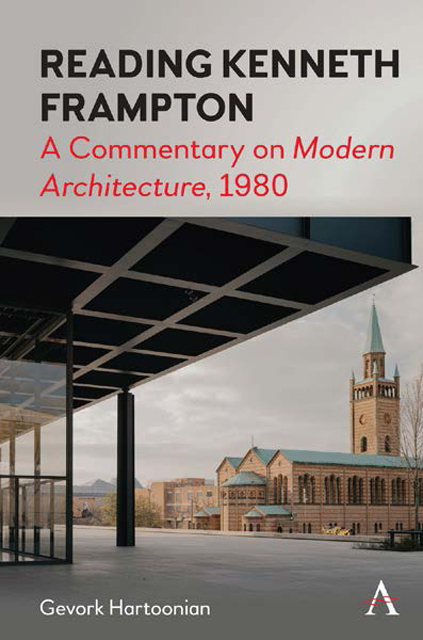Summary
Kenneth Frampton's historiographic taxonomy is essential for the project pursued in Modern Architecture: A Critical History, first published in 1980. The previous chapter demonstrated the extent to which a well-known passage from Walter Benjamin's “Thesis on the Philosophy of History” (1940) set the theoretical premises of Frampton's brief introductory remarks, notable aspects of which he elaborates on in the subsequent chapters of the book. It is to Frampton's credit that he writes the history of modern architecture while criticizing the Enlightenment idea of progress. His text also critiques the stakes involved in the avant-gardist failed attempt to catch up with the wind of progress (in artistic terms) that pushes Benjamin's angel of history forward. This “failure” speaks to the ideology of modernity, wherein “reality persisted independent of that sentimental and romantic ‘sphere of culture.’ “ Accordingly, it took almost half a century, Fredric Jameson contends, to face the vanishing stage of the suggested mode of separation, at least in the regions of the world that were the bedrock of early modernism. Call it the postmodern condition or the full-moon visibility of an ideology when alternative views are almost nullified, if not tossed to the dark orbit of history, at least for now.
At issue for a historian, among other things, was/is the possibility of maintaining a strategic distance from the Real without isolating historiography from the objective and subjective conditions of the everyday life that capitalism has successfully managed since the middle of the past century. Frampton maps the historicity of the formation of modern architecture in three chapters of the book's part I. He argues that what makes modernity distinct from the Classical are transformations implanted in the cultural, territorial and technical areas, which are discussed under the rubric of the “trilogy” below. These transformations run the historical gamut extending from 1750 to 1939. In addition to witnessing the emergence of architectonic expressions motivated by technical changes, the last years of the decade of the 1930s designate the end of modernity. This does not mean the literal end of modernity, a singular historical event that has attained global currency since the end of the Cold War (ca. 1990), but the loss of the theoretical currency of the modernity versus Classical paradigm.
- Type
- Chapter
- Information
- Reading Kenneth FramptonA Commentary on 'Modern Architecture', 1980, pp. 33 - 58Publisher: Anthem PressPrint publication year: 2022

